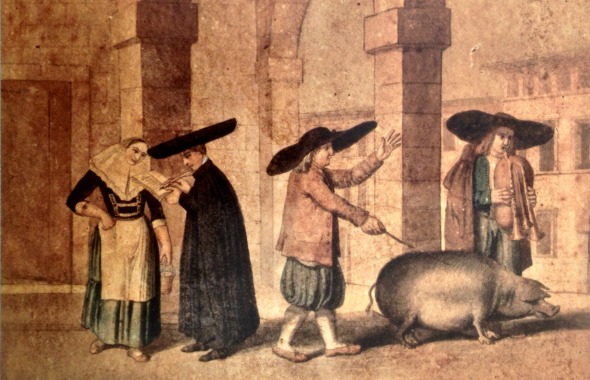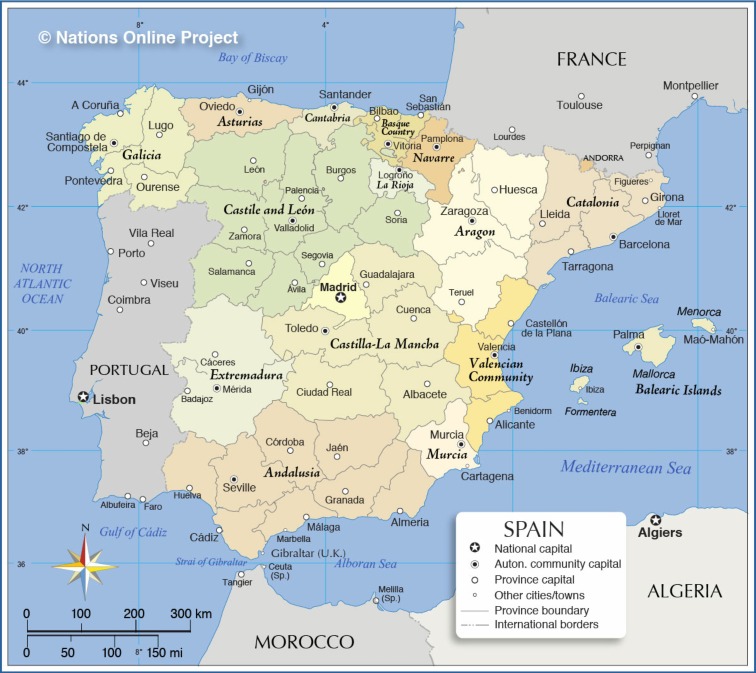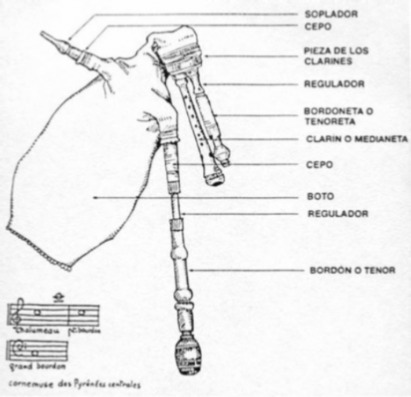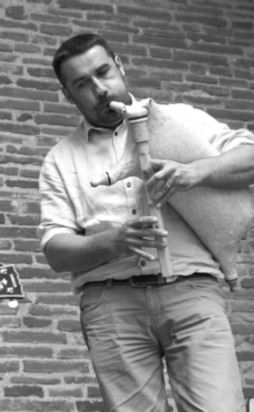The Bagpipe Society
A Short Overview of the Bagpipes from the Iberian Peninsula

The Iberian Peninsula is extremely rich in instruments. The bagpipe was a common instrument in the northern part of the country. This short overview of the different instruments one can find will hopefully give you an indication of the huge variety of bagpipes to be found in Spain and Portugal.
Gaita de fol (Galicia, Asturias, Portugal, Sanabria, Bierzo, Cantabria)
The gaita de fol (gaita with bag) is probably the best-known European bagpipe after the great Highland Bagpipe, mainly thanks to Galician musicians’ international careers such as Carlos Nuñez and Susana Seivane. Bagpipes have been present in Galician iconography since the medieval ages and have accompanied Galician music ever since. One of the oldest versions of the bagpipe featured in Iberian iconography includes a bag, a blowpipe, a drone and a double reed conical melodic pipe. This type of bagpipe was commonly found in Galicia, Asturias and Northern Portugal, Northern Zamora, in the Bierzo area (in the province of Leon), reaching the western part of Cantabria. From this large single-reed drone and double-reed conical chanter bagpipe, two main types of instruments can be identified: the Trasmontana (Northern Portugal) and Sanabria gaita and the gaita from Galicia, Portugal, Bierzo and Asturias. Within the second group, Pablo Carpintero distinguishes two further sub-groups: the gaitas from Northern Portugal to Lisbon (with the exception of the Trás-o-Monte region), Galicia, the Eo-Navia area in Western Asturias, Northern Sanabria and Bierzo and the gaitas from Asturias and Cantabria which, according to him, are nearly impossible to differentiate. There are fine and subtle differences within these sub-groups relating to the shape and size of the double reeds, the scales and how they go up the octave.

Gaita de fole (Trás-o-Montes in Portugal and Sanabria in Zamora)
The northern Portuguese gaita de fole consists of, much like the Galician version, a blowpipe, a drone and a double reed conical melodic pipe. Unlike the Galician gaita, however, the bagpipe from the Trasmonte region is thicker and less fine with a wider reed. Aside from its more rustic appearance, it uses a scale with a neutral third, which gives a distinctive character to its musical repertoire. Unlike many other bagpipe traditions that underwent a revival in the 1980s and opted to standardise the instrument by using a scale that was closer to the equal temperament in order to tune it to other instruments, the Portuguese revivalists chose to keep the characteristic scale of their bagpipes. This allowed them to maintain the organological characteristics of their instruments and to interpret their repertoire with a feeling of historical and musical continuity. See Susana Moreno’s article for more information.
Gaita de fol (Galicia)

The better-known Galician bagpipe is the gaita de fol with a double reed conical melodic pipe, a blowpipe and one to three drones. Although many now play on pipes with an open fingering system, developed to play major and minor scales on a range of well over an octave, some even approaching two octaves, older Galician bagpipes varied geographically. The greater part of Galicia used bagpipes with a single drone. These used chanters that, much like the Trás-o-Monte pipes today, had a neutral third and a low subtonic. There was a wide variety of tonalities all over the region with a tendency towards higher keys as one travelled northwards. Lower pitched bagpipes (B) were called tumbais and higher pitched bagpipes (D, Eb) were called grileiras Aside from these characteristics, only bagpipes the very northern part of Galicia went up the octave. Whereas most of southern and eastern Galicia played with open fingerings, the northern and northwestern areas of the region played with closed fingerings. Today, however, the instrument is very much standardised and only few people still play with closed fingerings. From the central parts of Galicia appeared the quartets, which are now widely played all throughout the region: two or three bagpipes, a small drum and a bass drum. Towards the southeast and eastern parts of Galicia, bagpipes were often played alone accompanied with a drum and a bass drum, sometimes joined by clarinets or small street bands. The secondary drones of the Galician bagpipes were probably added around the 17th or 18th century as no iconography prior to this period portrays bagpipes with more than one drone. The smaller, secondary drones were not placed on the shoulder but over the free arm of the piper and were initially found only on lower pitched instruments. Finally, in the very centre of Galicia, gaitas with three drones were played and made until the mid-20th century. The bass drone rested on the shoulder. The two smaller drones, one much shorter than the other, rested on the piper’s arm and were both inserted into a common stock that protruded laterally. Gaitas de fol had a central role in society as they were played at festivities not only for dancing but also for religious ceremonies and processions during patron saint celebrations. Like many other bagpipe traditions, it experienced a period of decline throughout the 20th century and was revived in the 1970s (see Anton Varela’s account in this edition). Today, the gaita is both a cultural and musical instrument, taught in conservatoires, schools and music schools. It represents a people and a region but it is also a musical instrument whose boundaries are constantly being pushed by young artists exploring different musical worlds. Additional technological developments have allowed the instrument to go into these new directions with synthetic bags, reliable reeds (both cane and plastic) and melodic pipes tuned to modern scales. Although the most common key is C, many pipers also play in D and more recently have started playing in G for a softer, lower sound, which allows them to play in sessions with others more easily. For more information and detailed images of the different gaitas: http://www.consellodacultura.gal/asg/instrumentos/indice-de-instrumentos/
Cane bagpipe (Galicia)
Now nearly forgotten, Galicia used to have small cane bagpipes. These consisted of an animal’s bladder fitted with a single reed cane chanter, a cane drone and a short cane blowpipe. They were mainly made for children and young people who showed an interest in music so that they could practice before playing a wooden bagpipe.
Gaita de Rosca (Galicia)
The gaita de rosca a single reed bagpipe found in Galicia. Found in the southern area of Baixo Miño, the remaining bagpipe consists of a single reed cylindrical chanter with a wooden horn attached to the end. Its name, rosca, seems to refer to the decorative nodes found on between each tone hole. The original specimen, provided by Alfonso Álvarez Pousa from Cristelos, Tomiño, in the Galician province of Pontevedra, had no bag. It was reconstructed by Pablo Carpintero following the instructions of the informant. According to the latter, this instrument was played both with and without a bag, the melodic chanter played directly from the mouth. Alfonso Álvarez Pousa had made two of these instruments in his lifetime: one in 1998 and one when he was a child. The melodic pipe was played with open fingerings and only had six tone holes, a thumbhole and three tuning holes on the horn. This instrument seems to share many characteristic with other single reed wind instruments found in the rest of Spain including the Portuguese palheta, the gaita de Gástor from Cádiz, the gaita serrana from Madrid or the Basque alboka. Interestingly, the Cantigas de Santa Maria (see illustration) seem to reference a bagpipe with a similar morphology in its illustrations, featuring what seems to be cylindrical melodic pipes with a perpendicular horn at its extremity. Much still needs to be discovered about this instrument, but, if its origins are indeed local, it would seem to be a relic of the single reed bagpipes that were probably found all over Europe. Pablo Carpintero, bagpipe maker and researcher playing the instrument at a conference: http://bit.ly/Chanter26
Gaita de barquin (Galicia)
The gaita de barquin (bellows bagpipe) is a lesser-known bagpipe found in Galicia and Portugal until the early 20th century. It was only played until the 1930s and by then was limited to the Baixo Miño area. It is thought that these bagpipes may have been played in Galicia since at least the late 18th century. Aside from the bellows, bagpipes of this kind that passed down to this day feature two shoulder drones emerging from a single stock. The two drones were of different size and played an octave apart. Other than this, the melodic pipes presented much the same characteristics to other contemporary instruments with a low third and subtonic. Some instruments did, however, have a small key that allowed musicians to play the tonic up the octave by uncovering a small hole in the middle of the pipe. This leads researchers to think that pipers playing the gaita de barquin probably did not play above the first octave, unlike other pipers from other parts of Galicia.
For more information see: González, C., Marín X. R. e Meixide, C. “Un instrumento esquecido: A gaita de barquín”. Pontevedra, revista de estudios provinciais, Nº 8-9
Gaita marcial (Galicia)
The gaita marcial (martial bagpipes) was invented by Xosé Luis Foxo in the late 1980s for the creation of his bagpipe band, the Real Banda de Gaitas de la Diputación de Ourense (the Royal Bagpipe Band of Orense). This bagpipe, called by some a Galician-Scottish hybrid features three drones slung over the shoulder, is tuned in Bb, and is played in a big band formation with artificial hide drums for processions with costumes that are not traditionally Galician. This caused great controversy in Galicia and ignited from the start what was called ‘la Guerra de las Gaitas’, the war of bagpipes, with musicians from all over Galicia taking sides.
Gaita Asturiana (Asturias and Cantabria)
Much like in Galicia, the bagpipes have been present in Asturias since the Middle Ages. In the 16th century, professional pipers were regularly registered in local archives. In the 19th century, many pipers were hired and paid by churches. This was the time of famous pipers such as the Gaiteru Llibardon who played at the International Exhibition in Paris in 1889 and later recorded the first known Asturian bagpipe album in Milan. Much like in other regions of Spain, the bagpipe declined throughout the 20th century and the instruments were put together with pieces from different bagpipes. However, there were still one or two active pipers per village although very few of them were well-known musicians. The Asturian bagpipes went through a revival in the 1980s. Bagpipes were not standardised and varied according to the individual choices of the artisans. Today, however, the model of bagpipes widely played is copied from Cogollu, an Asturian maker active at the end of the 19th century and the beginning of the 20th century. Asturian bagpipes are larger than the Galician bagpipes although they are played in the same key. They are played with closed fingerings and can easily go up the octave; its range extended to at least a fourth above the octave. Today, Asturian bagpipes are internationally represented thanks to the musician Hevia who is also well known for using electronic bagpipes in his music. More recently, since the beginning of the 21st century, the Cantabrians have also taken ownership of their bagpipe tradition although the instrument they play is virtually the same as the Asturian gaita.
Gaita de boto (Aragon)

The last player of the gaita de boto (boto: bag), Juan Mir Susín from Siriñena, died in 1975, marking the end of the instrument’s life. Bagpipes had been written about in Aragon since the 14th century although current versions of the instrument only dated back to the early 19th century. In 1980, however, after combined efforts with Pedro Mir, the last piper’s nephew, and Martín Blueca, the villager’s piper who played the Galician gaita, a copy of Juan Mir’s bagpipe was created. Little by little Aragon bagpipes reappeared in the region and in 1988 a dozen musicians gathered to meet in Ainsa, marking the first steps of the revival.
The gaita de boto, usually played in C, is formed of a double reed conical melodic pipe, two drones and a blowpipe. The small drone is parallel to the melodic pipe, both inserted into a common stock, much like Central French bagpipes. The longer drone rests on the shoulder and can be adorned with metallic engravings. Some older bagpipes had the different pipes covered with the skin of a grass snake. The bag is covered not with the more common textile case but with a small dress. Legend has it that a long time ago, a blind piper lost his young daughter. In order to remember her, he put her dress over his bagpipe so it would feel like he was holding her when he was playing. Since, bagpipe bags in Aragon are covered with colourful dresses.
For more information: Blueca Vitales, Martín and Pedro Mir Tierz, 1998. La gaita de boto aragonesa, coedited with the Asociación de Gaiteros de Aragón and the Diputación General de Aragón.
Bot Aranes (Pyrenees, North Catalonia)

This bagpipe, local from the Aran Valley on the northern border of Catalonia, not far from the city of Tarbes in France, is another single reed bagpipe found in Spain. The word bot means the skin flask. In the Pyrenees, where this bagpipe is to be found, these were mainly used to transport wine or oil. The instrument is formed of a blowpipe and a cylindrical melodic pipe with six holes, inserted into a stock attached to the bag from the neck. According to research, the instrument does not have any drones, specific decorations or any thumbhole.
The bot from Aran is thought to be a medieval bagpipe. Iconography of bagpipes presenting the same morphology dating from the 13th to 15th centuries can be found all over the Pyrenees and beyond. These pipes were survived in this valley although they were probably played in a much wider region, with morphological variations. In the early 20th century, they were played in the northern part of the Aran valley and were known throughout the region by people who met travelling musicians or who had lived in Aran. The bot from Aran was mainly played to keep the cows, to accompany singing and walking.
Today, bagpipe maker and musician Pierre Rouch, who researched the Aran Bot and many other wind instruments from the Pyrenees extensively, makes Aran pipes in B flat, the key that best matches the descriptions he gathered during his research.
Video of Pierre Rouch playing the bot from the Aran Valley at the Blowout in 2015 with the Matta Rouch trio: https://www.youtube.com/watch?v=aQIAQ2dx2-U
Sac de Gemecs (Catalonia)
The name sac de gemecs literally means bag of moans, probably referring to the sound made by the instrument. Bagpipes were widely played in Catalonia since the 13th century when it was often played at court. Since the 14th century, the Catalan pipes were played in different formations, mainly with a shawm and sometimes with another instrument, whether string or wind. This small ensemble was called a cobla and, over time established itself as a fixed formation of wind instruments. The bagpipes could be played within this formation, as a solo instrument or with a pipe and tabor, like in Mallorca. Very similar organologically to the Mallorcan bagpipes, the sac de gemecs disappeared from Catalonia in the early 20th century. Unlike in Mallorca, the sac de gemecs were not considered as shepherd instruments – these were more the realm of flutes and even shawms – and were mainly played by trained musicians. By the 1930s, no more bagpipes were played in Catalonia and the only surviving musician in the 1970s had not touched the instrument for decades. The sac de gemecs was revived in the 1980s after a couple of musicians visited Mallorca to understand more about their instrument and benefit from the knowledge gathered by the Mallorcan musicians who had had the opportunity to learn from an unbroken line of pipers. Since, the revival has taken off and many Catalan musicians play the vernacular bagpipes, thus becoming sacaires (pipers).
For more information: Busquets, Simó and Francesc Sans. Les cornamuses i el sac de gemecs. Sabadell. 1995
Or: http://elsacdegemecs.blogspot.co.uk
Xeremies (Mallorca)
The name comes from xeremie, xeremia or xirimia (shawm). These were shawms played since the Middle Ages in different cobla formations (see sac de gemecs). The word xeremies most probably makes references to the collection of shawms used in one instrument and is always used in the plural form.
The xeremies were traditionally made out of a one year-old goatskin. The rear end was tied and the neck and the two front legs were used for the pipes. The mouthpiece was attached to the left foreleg and the melodic pipe to the right foreleg. The xeremies boast three drones attached to a common stock that is fitted to the neck of the animal skin. The drones hang in front of the instrument, creating considerable counterweight for the musician. Until the 1970s, only the larger drone was in use. The two smaller drones were mute until they were opened by local pipe maker Joan Morey in the late 1980s. The loss of craftsmanship over the late 19th and early 20th century may have contributed to the muting of the two small drones. Today, however, the xeremies can be played with three drones (tonic, fifth and octave). The xeremies are traditionally played in C although other tunings (C and D) can be found in groups playing with other instruments.
The xeremies are traditionally played in a colla. The colla is the inseparable unit of a bagpipe player (xeremier) and a flute (flabiol) and drum (tambori) player. The flabiol is similar to a short recorder played with the five fingers of the left hand with the tambori slung over the palm, hit with a drumstick by the right hand. The colla is a solid unit formed of two musicians who often played together for life. Even nowadays, the bagpipes are rarely heard without the flabiol and the drums, including in modern bands. The unity of the duo is so strong that both musicians are referred to as ‘xeremiers’, whether they play the bagpipes or the flute and drum.

Bagpipes have been present in Mallorca since the 13th century. However, if one looks at local iconography in the 14th and 15th century this instrument had a smaller bag and no drones. The current morphology of the xeremies appears in the 18th century in the Christmas nativity statuettes. By then, the bagpipes had become a shepherd’s instrument and remained so until the revival in the 1970s. Bagpipes were played at night to keep the goats in the fields so that the landowner could hear from his bedroom that the shepherds were not sleeping. The colla was also essential to local celebrations and led the people into the revelry. After a period of decline in the 20th century, the xeremies were taken up by a new generation of young men in the 1970s. This led to a boom in the 1990s and 2000s. In contrast to the dozen xeremiers still alive in the 1970s, over 600 people play one of the colla instruments in Mallorca today.
- Data Processing Notice (GDPR)
-
@BagpipeSociety on X (formally known as Twitter)
-
TheBagpipeSociety on Instagram
-
 BagpipeSociety on Facebook
BagpipeSociety on Facebook
Something wrong or missing from this page? Let us know!
